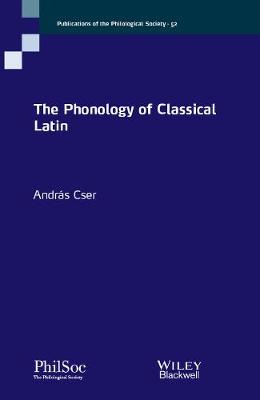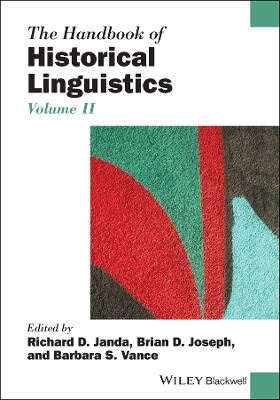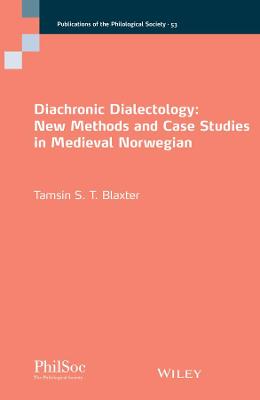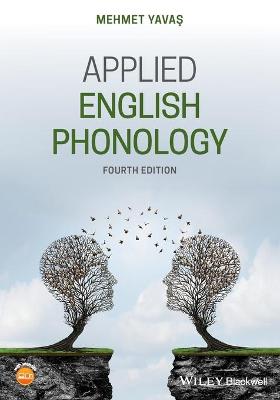Phonology of Classical Latin
 -15%
portes grátis
-15%
portes grátis
Phonology of Classical Latin
Cser, Andras
John Wiley and Sons Ltd
07/2020
240
Mole
Inglês
9781119700609
15 a 20 dias
374
Descrição não disponível.
List of figures
List of tables
Abbreviations and symbols
Acknowledgements
1. Introduction
1.1. Aims and scope 1
1.2. Previous research 1
1.3. The language, the data and the form of writing 2
1.4. The framework 7
1.5. The structure of the book 11
2. The segmental inventory 13
2.1. Introduction 13
2.2. Consonants 13
2.2.1. General distributional regularities in simplex forms 16
2.2.2. The question of the labiovelar(s) 20
2.2.2.1. The issue of frequency 22
2.2.2.2. Phonetic issues 22
2.2.2.3. Geminates 23
2.2.2.4. Positional restrictions and stop + glide sequences 24
2.2.2.5. The question of [sw] 25
2.2.2.6. Verb root structure 26
2.2.2.7. Voicing contrast in clusters 26
2.2.2.8. Alternations 27
2.2.2.9. Ad-assimilation 30
2.2.2.10. Diachronic considerations 30
2.2.2.11. Poetic licence 30
2.2.2.12. Further remarks on the voiced labiovelar 31
2.2.2.13. Summary of the labiovelar question 32
2.2.3. The placeless nasal 32
2.3. Vowels 34
2.3.1. The nasal vowels 35
2.3.2. The question of diphthongs 37
2.3.3. Hiatus 43
2.4. The phonological representations 44
2.5. Conclusion 46
3. The phonotactics of simplex forms and resyllabification 48
3.1. Introduction 48
3.1.1. Excursus on metrical evidence 50
3.2. The presentation of the consonant clusters 51
3.3. The analysis of the consonant clusters 51
3.4. Syllable contact and the interaction between place of articulation and sonority 67
3.5. Resyllabification and extrasyllabic [s] 70
3.6. A note on words written with initial?gn?74
3.7. Conclusion 81
4. Processes affecting consonants 82
4.1. Introduction 82
4.2. Contact voice assimilation 82
4.2.1. Excursus: loss of [s] before voiced consonants 84
4.3. Total assimilation of [t] to [s] 85
4.4. Rhotacism 86
4.5. Degemination 89
4.5.1. General degemination 89
4.5.2. Degemination of [s] 91
4.6. Nasal place loss before fricatives 92
4.7. Epenthesis after [m] 92
4.8. Place assimilation 94
4.9. Dark and clear [l] 96
4.10. Final stop deletion 99
4.11. Liquid dissimilation 100
4.12. Conclusion 103
5. Processes affecting vowels 104
5.1. Introduction 104
5.2. Alternations in vowel quality 104
5.2.1. The Old Latin weakening 104
5.2.2. Synchronic alternations between the short vowels 106
5.2.2.1. Alternation in closed vs. open syllables 106
5.2.2.2. Lowering before [r] 108
5.2.2.3. Word-final lowering 110
5.3. Vowel-zero alternations 111
5.3.1. Before stem-final [r] 111
5.3.2. Prevocalic deletion of back vowels 112
5.3.3. Vowel-zero alternation in suffixes 114
5.4. Length alternations 114
5.4.1. Shortenings 115
5.4.2. Lengthening before voiced stops 115
5.4.3. Coalescence with empty vowel 118
5.4.4. Coalescence with placeless nasal 119
5.4.5. The abies-pattern 121
5.5. Conclusion 123
6. The inflectional morphology of Classical Latin 124
6.1. Introduction 124
6.2. Allomorphy in the verbal inflection 126
6.2.1. The general structure of verbal inflection 126
6.2.2. Affixes immediately following the infectum stem 127
6.2.3. Affixes immediately following the perfectum stem 131
6.2.3.1. Classification of affixes 131
6.2.3.2. The general pattern of affix alternations 132
6.2.3.3. Vowel deletion after [s] 135
6.2.3.4. Hiatus and i-final perfectum stems 135
6.2.3.5. The non-alternating suffixes 137
6.2.4. Affixes following the extended stems 139
6.3. Allomorphy in the nominal inflection 141
6.3.1. Introductory remarks 141
6.3.2. Case endings and allomorphy: nominative and accusative singular 143
6.3.2.1. Phonological alternations in the nominative singular 144
6.3.2.2. Gender marking 145
6.3.3. Case endings and allomorphy: the remaining cases 146
6.4. Morphophonological analysis: inflectional allomorphy and the vocalic scale 149
6.5. The vocalic scale and sonority 150
6.6. Conclusion 152
7. The phonology of prefixed forms 153
7.1. Introduction 153
7.2. The prefixes of Latin 155
7.2.1. Vowel-final prefixes + prae 156
7.2.1.1. de- 156
7.2.1.2. pro- 156
7.2.1.3. se- 157
7.2.1.4. ne- 157
7.2.1.5. re- 157
7.2.1.6. ambi- 158
7.2.1.7. ante- 159
7.2.1.8. ve- 160
7.2.1.9. prae- 160
7.2.2. Prefixes ending in [r] 160
7.2.2.1. per- 160
7.2.2.2. super- 161
7.2.2.3. subter- 161
7.2.2.4. inter- 161
7.2.2.5. por- 161
7.2.3. Nasal-final prefixes 161
7.2.3.1. in- 161
7.2.3.2. con- 162
7.2.3.3. an- 165
7.2.3.4. circum- 165
7.2.4. Coronal obstruent-final prefixes 166
7.2.4.1. post- 166
7.2.4.2. ex- 166
7.2.4.3. dis- 168
7.2.4.4. trans- 169
7.2.4.5. ad- 170
7.2.5. Prefixes ending in [b] 172
7.2.5.1. ob- 172
7.2.5.2. ab- 173
7.2.5.3. sub- 175
7.3. Generalisations 176
7.3.1. Assimilations 176
7.3.1.1. Voice assimilation 176
7.3.1.2. Place assimilation 176
7.3.1.3. Total assimilation 177
7.3.2. Non-assimilatory allomorphy 179
7.3.2.1. [s]-allomorphy 179
7.3.2.2. Vowel-triggered allomorphy 179
7.3.2.3. [b]-allomorphy 180
7.3.3. On the nature of prefix-variation 180
7.4. Conclusion 183
8. Conclusion and conspectus of the phonological rules 184
Appendix 1: The textual frequency of consonants in Classical Latin
Appendix 2: Authors and works mentioned in the text
References
Index of Latin words
Subject index
List of tables
Abbreviations and symbols
Acknowledgements
1. Introduction
1.1. Aims and scope 1
1.2. Previous research 1
1.3. The language, the data and the form of writing 2
1.4. The framework 7
1.5. The structure of the book 11
2. The segmental inventory 13
2.1. Introduction 13
2.2. Consonants 13
2.2.1. General distributional regularities in simplex forms 16
2.2.2. The question of the labiovelar(s) 20
2.2.2.1. The issue of frequency 22
2.2.2.2. Phonetic issues 22
2.2.2.3. Geminates 23
2.2.2.4. Positional restrictions and stop + glide sequences 24
2.2.2.5. The question of [sw] 25
2.2.2.6. Verb root structure 26
2.2.2.7. Voicing contrast in clusters 26
2.2.2.8. Alternations 27
2.2.2.9. Ad-assimilation 30
2.2.2.10. Diachronic considerations 30
2.2.2.11. Poetic licence 30
2.2.2.12. Further remarks on the voiced labiovelar 31
2.2.2.13. Summary of the labiovelar question 32
2.2.3. The placeless nasal 32
2.3. Vowels 34
2.3.1. The nasal vowels 35
2.3.2. The question of diphthongs 37
2.3.3. Hiatus 43
2.4. The phonological representations 44
2.5. Conclusion 46
3. The phonotactics of simplex forms and resyllabification 48
3.1. Introduction 48
3.1.1. Excursus on metrical evidence 50
3.2. The presentation of the consonant clusters 51
3.3. The analysis of the consonant clusters 51
3.4. Syllable contact and the interaction between place of articulation and sonority 67
3.5. Resyllabification and extrasyllabic [s] 70
3.6. A note on words written with initial?gn?74
3.7. Conclusion 81
4. Processes affecting consonants 82
4.1. Introduction 82
4.2. Contact voice assimilation 82
4.2.1. Excursus: loss of [s] before voiced consonants 84
4.3. Total assimilation of [t] to [s] 85
4.4. Rhotacism 86
4.5. Degemination 89
4.5.1. General degemination 89
4.5.2. Degemination of [s] 91
4.6. Nasal place loss before fricatives 92
4.7. Epenthesis after [m] 92
4.8. Place assimilation 94
4.9. Dark and clear [l] 96
4.10. Final stop deletion 99
4.11. Liquid dissimilation 100
4.12. Conclusion 103
5. Processes affecting vowels 104
5.1. Introduction 104
5.2. Alternations in vowel quality 104
5.2.1. The Old Latin weakening 104
5.2.2. Synchronic alternations between the short vowels 106
5.2.2.1. Alternation in closed vs. open syllables 106
5.2.2.2. Lowering before [r] 108
5.2.2.3. Word-final lowering 110
5.3. Vowel-zero alternations 111
5.3.1. Before stem-final [r] 111
5.3.2. Prevocalic deletion of back vowels 112
5.3.3. Vowel-zero alternation in suffixes 114
5.4. Length alternations 114
5.4.1. Shortenings 115
5.4.2. Lengthening before voiced stops 115
5.4.3. Coalescence with empty vowel 118
5.4.4. Coalescence with placeless nasal 119
5.4.5. The abies-pattern 121
5.5. Conclusion 123
6. The inflectional morphology of Classical Latin 124
6.1. Introduction 124
6.2. Allomorphy in the verbal inflection 126
6.2.1. The general structure of verbal inflection 126
6.2.2. Affixes immediately following the infectum stem 127
6.2.3. Affixes immediately following the perfectum stem 131
6.2.3.1. Classification of affixes 131
6.2.3.2. The general pattern of affix alternations 132
6.2.3.3. Vowel deletion after [s] 135
6.2.3.4. Hiatus and i-final perfectum stems 135
6.2.3.5. The non-alternating suffixes 137
6.2.4. Affixes following the extended stems 139
6.3. Allomorphy in the nominal inflection 141
6.3.1. Introductory remarks 141
6.3.2. Case endings and allomorphy: nominative and accusative singular 143
6.3.2.1. Phonological alternations in the nominative singular 144
6.3.2.2. Gender marking 145
6.3.3. Case endings and allomorphy: the remaining cases 146
6.4. Morphophonological analysis: inflectional allomorphy and the vocalic scale 149
6.5. The vocalic scale and sonority 150
6.6. Conclusion 152
7. The phonology of prefixed forms 153
7.1. Introduction 153
7.2. The prefixes of Latin 155
7.2.1. Vowel-final prefixes + prae 156
7.2.1.1. de- 156
7.2.1.2. pro- 156
7.2.1.3. se- 157
7.2.1.4. ne- 157
7.2.1.5. re- 157
7.2.1.6. ambi- 158
7.2.1.7. ante- 159
7.2.1.8. ve- 160
7.2.1.9. prae- 160
7.2.2. Prefixes ending in [r] 160
7.2.2.1. per- 160
7.2.2.2. super- 161
7.2.2.3. subter- 161
7.2.2.4. inter- 161
7.2.2.5. por- 161
7.2.3. Nasal-final prefixes 161
7.2.3.1. in- 161
7.2.3.2. con- 162
7.2.3.3. an- 165
7.2.3.4. circum- 165
7.2.4. Coronal obstruent-final prefixes 166
7.2.4.1. post- 166
7.2.4.2. ex- 166
7.2.4.3. dis- 168
7.2.4.4. trans- 169
7.2.4.5. ad- 170
7.2.5. Prefixes ending in [b] 172
7.2.5.1. ob- 172
7.2.5.2. ab- 173
7.2.5.3. sub- 175
7.3. Generalisations 176
7.3.1. Assimilations 176
7.3.1.1. Voice assimilation 176
7.3.1.2. Place assimilation 176
7.3.1.3. Total assimilation 177
7.3.2. Non-assimilatory allomorphy 179
7.3.2.1. [s]-allomorphy 179
7.3.2.2. Vowel-triggered allomorphy 179
7.3.2.3. [b]-allomorphy 180
7.3.3. On the nature of prefix-variation 180
7.4. Conclusion 183
8. Conclusion and conspectus of the phonological rules 184
Appendix 1: The textual frequency of consonants in Classical Latin
Appendix 2: Authors and works mentioned in the text
References
Index of Latin words
Subject index
Este título pertence ao(s) assunto(s) indicados(s). Para ver outros títulos clique no assunto desejado.
List of figures
List of tables
Abbreviations and symbols
Acknowledgements
1. Introduction
1.1. Aims and scope 1
1.2. Previous research 1
1.3. The language, the data and the form of writing 2
1.4. The framework 7
1.5. The structure of the book 11
2. The segmental inventory 13
2.1. Introduction 13
2.2. Consonants 13
2.2.1. General distributional regularities in simplex forms 16
2.2.2. The question of the labiovelar(s) 20
2.2.2.1. The issue of frequency 22
2.2.2.2. Phonetic issues 22
2.2.2.3. Geminates 23
2.2.2.4. Positional restrictions and stop + glide sequences 24
2.2.2.5. The question of [sw] 25
2.2.2.6. Verb root structure 26
2.2.2.7. Voicing contrast in clusters 26
2.2.2.8. Alternations 27
2.2.2.9. Ad-assimilation 30
2.2.2.10. Diachronic considerations 30
2.2.2.11. Poetic licence 30
2.2.2.12. Further remarks on the voiced labiovelar 31
2.2.2.13. Summary of the labiovelar question 32
2.2.3. The placeless nasal 32
2.3. Vowels 34
2.3.1. The nasal vowels 35
2.3.2. The question of diphthongs 37
2.3.3. Hiatus 43
2.4. The phonological representations 44
2.5. Conclusion 46
3. The phonotactics of simplex forms and resyllabification 48
3.1. Introduction 48
3.1.1. Excursus on metrical evidence 50
3.2. The presentation of the consonant clusters 51
3.3. The analysis of the consonant clusters 51
3.4. Syllable contact and the interaction between place of articulation and sonority 67
3.5. Resyllabification and extrasyllabic [s] 70
3.6. A note on words written with initial?gn?74
3.7. Conclusion 81
4. Processes affecting consonants 82
4.1. Introduction 82
4.2. Contact voice assimilation 82
4.2.1. Excursus: loss of [s] before voiced consonants 84
4.3. Total assimilation of [t] to [s] 85
4.4. Rhotacism 86
4.5. Degemination 89
4.5.1. General degemination 89
4.5.2. Degemination of [s] 91
4.6. Nasal place loss before fricatives 92
4.7. Epenthesis after [m] 92
4.8. Place assimilation 94
4.9. Dark and clear [l] 96
4.10. Final stop deletion 99
4.11. Liquid dissimilation 100
4.12. Conclusion 103
5. Processes affecting vowels 104
5.1. Introduction 104
5.2. Alternations in vowel quality 104
5.2.1. The Old Latin weakening 104
5.2.2. Synchronic alternations between the short vowels 106
5.2.2.1. Alternation in closed vs. open syllables 106
5.2.2.2. Lowering before [r] 108
5.2.2.3. Word-final lowering 110
5.3. Vowel-zero alternations 111
5.3.1. Before stem-final [r] 111
5.3.2. Prevocalic deletion of back vowels 112
5.3.3. Vowel-zero alternation in suffixes 114
5.4. Length alternations 114
5.4.1. Shortenings 115
5.4.2. Lengthening before voiced stops 115
5.4.3. Coalescence with empty vowel 118
5.4.4. Coalescence with placeless nasal 119
5.4.5. The abies-pattern 121
5.5. Conclusion 123
6. The inflectional morphology of Classical Latin 124
6.1. Introduction 124
6.2. Allomorphy in the verbal inflection 126
6.2.1. The general structure of verbal inflection 126
6.2.2. Affixes immediately following the infectum stem 127
6.2.3. Affixes immediately following the perfectum stem 131
6.2.3.1. Classification of affixes 131
6.2.3.2. The general pattern of affix alternations 132
6.2.3.3. Vowel deletion after [s] 135
6.2.3.4. Hiatus and i-final perfectum stems 135
6.2.3.5. The non-alternating suffixes 137
6.2.4. Affixes following the extended stems 139
6.3. Allomorphy in the nominal inflection 141
6.3.1. Introductory remarks 141
6.3.2. Case endings and allomorphy: nominative and accusative singular 143
6.3.2.1. Phonological alternations in the nominative singular 144
6.3.2.2. Gender marking 145
6.3.3. Case endings and allomorphy: the remaining cases 146
6.4. Morphophonological analysis: inflectional allomorphy and the vocalic scale 149
6.5. The vocalic scale and sonority 150
6.6. Conclusion 152
7. The phonology of prefixed forms 153
7.1. Introduction 153
7.2. The prefixes of Latin 155
7.2.1. Vowel-final prefixes + prae 156
7.2.1.1. de- 156
7.2.1.2. pro- 156
7.2.1.3. se- 157
7.2.1.4. ne- 157
7.2.1.5. re- 157
7.2.1.6. ambi- 158
7.2.1.7. ante- 159
7.2.1.8. ve- 160
7.2.1.9. prae- 160
7.2.2. Prefixes ending in [r] 160
7.2.2.1. per- 160
7.2.2.2. super- 161
7.2.2.3. subter- 161
7.2.2.4. inter- 161
7.2.2.5. por- 161
7.2.3. Nasal-final prefixes 161
7.2.3.1. in- 161
7.2.3.2. con- 162
7.2.3.3. an- 165
7.2.3.4. circum- 165
7.2.4. Coronal obstruent-final prefixes 166
7.2.4.1. post- 166
7.2.4.2. ex- 166
7.2.4.3. dis- 168
7.2.4.4. trans- 169
7.2.4.5. ad- 170
7.2.5. Prefixes ending in [b] 172
7.2.5.1. ob- 172
7.2.5.2. ab- 173
7.2.5.3. sub- 175
7.3. Generalisations 176
7.3.1. Assimilations 176
7.3.1.1. Voice assimilation 176
7.3.1.2. Place assimilation 176
7.3.1.3. Total assimilation 177
7.3.2. Non-assimilatory allomorphy 179
7.3.2.1. [s]-allomorphy 179
7.3.2.2. Vowel-triggered allomorphy 179
7.3.2.3. [b]-allomorphy 180
7.3.3. On the nature of prefix-variation 180
7.4. Conclusion 183
8. Conclusion and conspectus of the phonological rules 184
Appendix 1: The textual frequency of consonants in Classical Latin
Appendix 2: Authors and works mentioned in the text
References
Index of Latin words
Subject index
List of tables
Abbreviations and symbols
Acknowledgements
1. Introduction
1.1. Aims and scope 1
1.2. Previous research 1
1.3. The language, the data and the form of writing 2
1.4. The framework 7
1.5. The structure of the book 11
2. The segmental inventory 13
2.1. Introduction 13
2.2. Consonants 13
2.2.1. General distributional regularities in simplex forms 16
2.2.2. The question of the labiovelar(s) 20
2.2.2.1. The issue of frequency 22
2.2.2.2. Phonetic issues 22
2.2.2.3. Geminates 23
2.2.2.4. Positional restrictions and stop + glide sequences 24
2.2.2.5. The question of [sw] 25
2.2.2.6. Verb root structure 26
2.2.2.7. Voicing contrast in clusters 26
2.2.2.8. Alternations 27
2.2.2.9. Ad-assimilation 30
2.2.2.10. Diachronic considerations 30
2.2.2.11. Poetic licence 30
2.2.2.12. Further remarks on the voiced labiovelar 31
2.2.2.13. Summary of the labiovelar question 32
2.2.3. The placeless nasal 32
2.3. Vowels 34
2.3.1. The nasal vowels 35
2.3.2. The question of diphthongs 37
2.3.3. Hiatus 43
2.4. The phonological representations 44
2.5. Conclusion 46
3. The phonotactics of simplex forms and resyllabification 48
3.1. Introduction 48
3.1.1. Excursus on metrical evidence 50
3.2. The presentation of the consonant clusters 51
3.3. The analysis of the consonant clusters 51
3.4. Syllable contact and the interaction between place of articulation and sonority 67
3.5. Resyllabification and extrasyllabic [s] 70
3.6. A note on words written with initial?gn?74
3.7. Conclusion 81
4. Processes affecting consonants 82
4.1. Introduction 82
4.2. Contact voice assimilation 82
4.2.1. Excursus: loss of [s] before voiced consonants 84
4.3. Total assimilation of [t] to [s] 85
4.4. Rhotacism 86
4.5. Degemination 89
4.5.1. General degemination 89
4.5.2. Degemination of [s] 91
4.6. Nasal place loss before fricatives 92
4.7. Epenthesis after [m] 92
4.8. Place assimilation 94
4.9. Dark and clear [l] 96
4.10. Final stop deletion 99
4.11. Liquid dissimilation 100
4.12. Conclusion 103
5. Processes affecting vowels 104
5.1. Introduction 104
5.2. Alternations in vowel quality 104
5.2.1. The Old Latin weakening 104
5.2.2. Synchronic alternations between the short vowels 106
5.2.2.1. Alternation in closed vs. open syllables 106
5.2.2.2. Lowering before [r] 108
5.2.2.3. Word-final lowering 110
5.3. Vowel-zero alternations 111
5.3.1. Before stem-final [r] 111
5.3.2. Prevocalic deletion of back vowels 112
5.3.3. Vowel-zero alternation in suffixes 114
5.4. Length alternations 114
5.4.1. Shortenings 115
5.4.2. Lengthening before voiced stops 115
5.4.3. Coalescence with empty vowel 118
5.4.4. Coalescence with placeless nasal 119
5.4.5. The abies-pattern 121
5.5. Conclusion 123
6. The inflectional morphology of Classical Latin 124
6.1. Introduction 124
6.2. Allomorphy in the verbal inflection 126
6.2.1. The general structure of verbal inflection 126
6.2.2. Affixes immediately following the infectum stem 127
6.2.3. Affixes immediately following the perfectum stem 131
6.2.3.1. Classification of affixes 131
6.2.3.2. The general pattern of affix alternations 132
6.2.3.3. Vowel deletion after [s] 135
6.2.3.4. Hiatus and i-final perfectum stems 135
6.2.3.5. The non-alternating suffixes 137
6.2.4. Affixes following the extended stems 139
6.3. Allomorphy in the nominal inflection 141
6.3.1. Introductory remarks 141
6.3.2. Case endings and allomorphy: nominative and accusative singular 143
6.3.2.1. Phonological alternations in the nominative singular 144
6.3.2.2. Gender marking 145
6.3.3. Case endings and allomorphy: the remaining cases 146
6.4. Morphophonological analysis: inflectional allomorphy and the vocalic scale 149
6.5. The vocalic scale and sonority 150
6.6. Conclusion 152
7. The phonology of prefixed forms 153
7.1. Introduction 153
7.2. The prefixes of Latin 155
7.2.1. Vowel-final prefixes + prae 156
7.2.1.1. de- 156
7.2.1.2. pro- 156
7.2.1.3. se- 157
7.2.1.4. ne- 157
7.2.1.5. re- 157
7.2.1.6. ambi- 158
7.2.1.7. ante- 159
7.2.1.8. ve- 160
7.2.1.9. prae- 160
7.2.2. Prefixes ending in [r] 160
7.2.2.1. per- 160
7.2.2.2. super- 161
7.2.2.3. subter- 161
7.2.2.4. inter- 161
7.2.2.5. por- 161
7.2.3. Nasal-final prefixes 161
7.2.3.1. in- 161
7.2.3.2. con- 162
7.2.3.3. an- 165
7.2.3.4. circum- 165
7.2.4. Coronal obstruent-final prefixes 166
7.2.4.1. post- 166
7.2.4.2. ex- 166
7.2.4.3. dis- 168
7.2.4.4. trans- 169
7.2.4.5. ad- 170
7.2.5. Prefixes ending in [b] 172
7.2.5.1. ob- 172
7.2.5.2. ab- 173
7.2.5.3. sub- 175
7.3. Generalisations 176
7.3.1. Assimilations 176
7.3.1.1. Voice assimilation 176
7.3.1.2. Place assimilation 176
7.3.1.3. Total assimilation 177
7.3.2. Non-assimilatory allomorphy 179
7.3.2.1. [s]-allomorphy 179
7.3.2.2. Vowel-triggered allomorphy 179
7.3.2.3. [b]-allomorphy 180
7.3.3. On the nature of prefix-variation 180
7.4. Conclusion 183
8. Conclusion and conspectus of the phonological rules 184
Appendix 1: The textual frequency of consonants in Classical Latin
Appendix 2: Authors and works mentioned in the text
References
Index of Latin words
Subject index
Este título pertence ao(s) assunto(s) indicados(s). Para ver outros títulos clique no assunto desejado.







